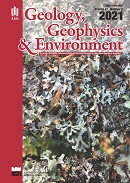An application of the NSGA-II algorithm in Pareto joint inversion of 2D magnetic and gravity data
Main Article Content
Keywords
NSGA-II, Pareto joint inversion, magnetometry, gravimetry
Abstract
Joint inversion is a widely used geophysical method that allows model parameters to be obtained from the observed data. Pareto inversion results are a set of solutions that include the Pareto front, which consists of non-dominated solutions. All solutions from the Pareto front are considered the most feasible models from which a particular one can be chosen as the final solution. In this paper, it is shown that models represented by points on the Pareto front do not reflect the shape of the real model. In this contribution, a collective approach is proposed to interpret the geometry of models retrieved in inversion. Instead of choosing single solutions from the Pareto front, all obtained solutions were combined in one “heat map”, which is a plot representing the frequency of points belonging to all returned objects from the solution set. The conducted experiment showed that this approach limits the problem of equivalence and is a promising way of representing the geometry of the model that was retrieved in the inversion process.
Downloads
References
Ayani M., MacGregor L. & Mallick S., 2020. Inversion of marine controlled source electromagnetic data using a parallel non-dominated sorting genetic algorithm. Geophysical Journal International, 220, 2, 1066–1077. https://doi.org/10.1093/gji/ggz501.
Bai H., Zheng J., Yu G., Yang S. & Zou J., 2019. A Pareto-based many-objective evolutionary algorithm using space partitioning selection and angle-based truncation. Information Sciences, 478, 186–207. https://doi.org/10.1016/j.ins.2018.10.027.
Currenti G., Napoli R., Sicali A., Greco F. & Negro C.D., 2014. GEOFIM: A WebGIS application for integrated geophysical modeling in active volcanic regions. Computers & Geosciences, 70, 120–127. https://doi.org/10.1016/j.cageo.2014.05.001.
Cervelli P., Murray M.H., Segall P., Aoki Y. & Kato T., 2001. Estimating source parameters from deformation data, with an application to the March 1997 earthquake warm off the Izu Peninsula, Japan. JGR: Solid Earth, 106, B6, 217–237.
Danek T., Leśniak A., Miernik K. & Śledź E., 2019. Pareto joint inversion of 2D magnetometric and gravity data – synthetic study. E3S Web of Conferences, 133, 01009. https://doi.org/10.1051/e3sconf/201913301009.
Deb K. & Srinivas N., 1994. Multiobjective optimization using nondominated sorting in genetic algorithms. Evolutionary Computation, 2, 3, 221–248.
Deb K., Pratap A., Agarwal S. & Meyarivan T., 2002. A fast and elitist multiobjective genetic algorithm: NSGA-II. IEEE Transactions on Evolutionary Computation – TEC, 6, 182–197. https://doi.org/10.1109/4235.996017.
Fang X., Wang W., He L., Huang Z., Liu Y. & Zhang L., 2018. Research on improved NSGA-II algorithm and its application in emergency management. Mathematical Problems in Engineering, 12, 1–13. https://doi.org/10.1155/2018/1306341.
Hinze W.J., Von Frese R.R.B. & Saad A.H., 2013. Gravity and Magnetic Exploration: Principles, Practices, and Applications. Cambridge University Press, Cambridge.
Jaszkiewicz A., 2018. Many-Objective Pareto Local Search. European Journal of Operational Research, 271, 3, 1001–1013. https://doi.org/10.1016/j.ejor.2018.06.009.
Jeyadevi S., Baskar S., Babulal C.K. & Iruthayarajan M.W., 2011. Solving multiobjective optimal reactive power dispatch using modified NSGA-II. International Journal of Electrical Power & Energy Systems, 33, 2, 219–228. https://doi.org/10.1016/j.ijepes.2010.08.017.
Kennedy J. & Eberhart R., 1995. Particle swarm optimization. [in:] Proceedings of ICNN ‘95: International Conference on Neural Networks: 27 November–1 December 1995, Perth, WA, Australia, 4, IEEE, 1942–1948.
Kozlovskaya E., Vecsey L., Plomerova J. & Raita T., 2007. Joint inversion of multiple data types with the use of multiobjective optimization: problem formulation and application to the seismic anisotropy investigations Geophysical Journal International, 171, 2, 761–779. https://doi.org/10.1111/j.1365-246X.2007.03540.x.
Kung H., Luccio F. & Preparata F., 1975. On finding the maxima of a set of vectors. Journal of the ACM, 22, 4, 469–476.
Liu D., Huang Q., Yang Y., Liu D. & Wei X., 2020. Bi-objective algorithm based on NSGA-II framework to optimize reservoirs operation. Journal of Hydrology, 585, 124830. https://doi.org/10.1016/j.jhydrol.2020.124830.
Martínez S., Perez E., Eguia P., Erkoreka A. & Granada E., 2020. Model calibration and exergoeconomic optimization with NSGA-II applied to a residential cogeneration. Applied Thermal Engineering, 169, 114916. https://doi.org/10.1016/j.applthermaleng.2020.114916.
Menke W., 1989. Geophysical Data Analysis: Discrete Inverse Theory. Elsevier.
Miernik K., Bogacz A., Kozubal A., Danek T. & Wojdyła M., 2016. Pareto joint inversion of 2D magnetotelluric and gravity data - towards practical applications. Acta Geophysica, 64, 5, 1655–1672. https://doi.org/10.1515/acgeo-2016-0035.
Mustaffa S.A.S., Musirin I., Zamani M.K.M. & Othman M.M., 2019. Pareto optimal approach in Multi-Objective Chaotic Mutation Immune Evolutionary Programming (MOCMIEP) for optimal Distributed Generation Photovoltaic (DGPV) integration in power system. Ain Shams Engineering Journal, 10, 4, 745–754. https://doi.org/10.1016/j.asej.2019.04.006.
Schwarzbach C., Börner R. & Spitzer K., 2005. Two-dimensional inversion of direct current resistivity data using a parallel, multi-objective genetic algorithm. Geophysical Journal International, 162, 3, 685–695. https://doi.org/10.1111/j.1365-246X.2005.02702.x.
Smith T., Hoversten M., Gasperikova E. & Morrison E., 1999. Sharp boundary inversion of 2D magnetotelluric data. Geophysical Prospecting, 47, 4. 469–486. https://doi.org/10.1046/j.1365-2478.1999.00145.x.
Socco L.V. & Boiero D., 2008. Improved Monte Carlo inversion of surface wave data. Geophysical Prospecting, 56, 357–371. https://doi.org/10.1111/j.1365-2478.2007.00678.x.
Śledź E. & Miernik K., 2019. Implementacja modelowania pola magnetycznego jako modułu systemu M.A.R.I.A (Modular Approach Robust Inversion Algorithm) realizującego połączoną inwersję Pareto. [in:] Dokonania Naukowe Doktorantów – edycja VII: materiały konferencji młodych naukowców nt. Dokonania Naukowe Doktorantów VII, Poznań 30.03.2019 oraz Kraków 6.04.2019, Warszawa 14.04.2019: materiały konferencyjne: streszczenia wystąpień, CREATIVETIME, Kraków, 82.
Tarantola A., 1987. Inverse Problem Theory: Methods for Data Fitting and Model Parameter Estimation. Elsevier.
Vozoff K. & Jupp D.L.B, 1975. Joint inversion of geophysical data. Geophysical Journal of the Royal Astronomical Society, 42, 3, 977–991.
Wang H., Fu Y., Huang M., Huang G.Q. & Wang J., 2017. A NSGA-II based memetic algorithm for multiobjective parallel flowshop scheduling problem. Computers & Industrial Engineering, 113, 185–194. https://doi.org/10.1016/j.cie.2017.09.009.
Zaefferer M., Naujoks B. & Bartz-Beielstein T., 2013. A gentle introduction to multi-criteria optimization with SPOT. Schriftenreihe CIplus.


